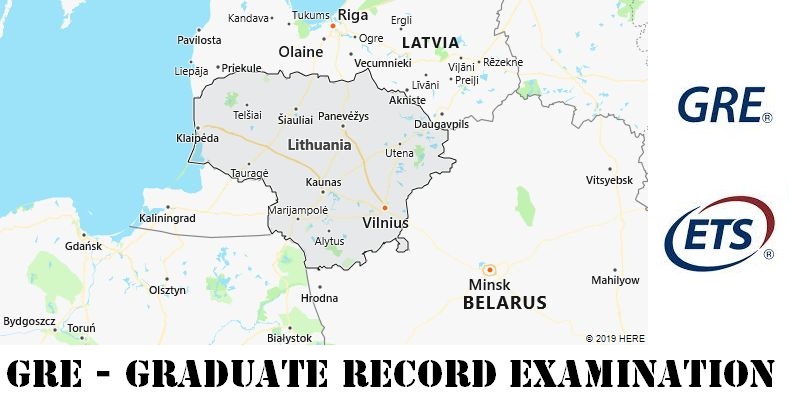GRE Testing Locations
Decided to take GRE exam? Now it is time to determine where to take the test. This site provides a full list of GRE testing centers in Lithuania, among which, you can choose one that is nearest to you. Good news is that the following GRE test locations in Lithuania offer both GRE general test and the GRE subject tests.

- VILNIUS, LITHUANIA – APCU-8448
Mykolas Romeris University II, Ateities g. 20 ? 137,, VILNIUS
Lithuania LT08303
Computer Based Test
GRE Test Dates
There are two types of test format offered by the test maker – ETS: Computer-delivered and Paper-delivered GRE general tests. For computer based test format, the GRE General Test is offered year-round on a continuous basis, and available for registration on a first-come, first-served basis. For paper based general test, testing is available three times per year. The following test dates apply:
| Test Dates for Paper Based | Deadlines for Registration | Scores Available |
|---|---|---|
| November 09, 2019 | October 4, 2019 | December 20, 2019 |
| February 1, 2020 | December 27, 2019 | March 13, 2020 |
GRE Subject Tests in Lithuania
The GRE Subject Tests are available on paper based only. In all GRE test centers throughout the world (both inside and outside United States), the exam is available three times a year. The three test dates are:
- April
- September
- October

More about Lithuania
Lithuanian music
Lithuanian music. In addition to the predominantly unanimous folk songs (Daina), which, like the epic chants, have a lyrical basic trait, the Sutartines (polyphonic chants) form a special group of traditional songs. Typical folk musical instruments include kankles (a type of zither), ožragis (wind instrument made from a goat horn) and bagpipes. – Professional forms of musical life have been known in Lithuania since the 14th century; Singing schools already existed in the 16th century. In 1900, M. K. Čiurlionis became the founder of Lithuanian symphonic music. The first national opera (»Biruté«, 1906) was written by Mikas Petrauskas (* 1873, † 1937).
At the beginning of the 1940s there was a significant boom in musical life. With the extensive inclusion of folk music, numerous works of different genres were created, including by Balys Dvarionas (* 1904, † 1972), Antanas Račiūnas (* 1905, † 1984) and Stasys Vainiūnas (* 1909, † 1982). Typical of the late 1970s and early 1980s was the tendency towards nostalgic, contemplative, and minimalist compositions, which were reflected in lyrical, meditative moods. Works of this kind wrote e.g. B. Bronius Kutavičius (* 1932) and Feliksas Bajoras (* 1934) and Mindaugas Urbaitis (* 1952). Modern compositional techniques and carefully selected musical design elements also characterize the music of Osvaldas Balakauskas (* 1937). Other well-known composers in the country are Julius Juzeliūnas (* 1916, † 2001), Eduardas Balsys (* 1919, † 1984), Antanas Rekašius (* 1928, † 2003), Vytautas Laurušas (* 1930) and Vytautas Prano Barkauskas (* 1931, † 2020). From the younger generation of composers, v. a. Algirdas Martinaitis (* 1950), Onute Narbutaite (* 1956), Rytis Mažulis (* 1961) and Antanas Jasenka (* 1965) emerged. To promote national music culture, Lithuania was awarded the Polar Music Prize in 1992, along with the other two Baltic states.
Culture
Artist colonies and dunes – seaside resorts on the Curonian Spit
Nidden and Schwarzort, today Nida and Juodkrantė, originally fishing villages on the Curonian Spit, developed in the late 19th century into health resorts and seaside resorts that were known for their peculiar, romantic character. Lovis Corinth, Max Pechstein, Karl Schmidt-Rottluff and other artists came to the Spit in the first third of the 20th century to enjoy the beauty of nature and to work here. Thomas Mann also spent several summers in Nidden. In his “Nidden Diary” he wrote: “The strip of land is 96 kilometers long and so narrow that it can be comfortably crossed from the lagoon to the sea in 20 minutes or half an hour.” At another point it says: “You know them List dunes on Sylt? You have to think fivefold, you think you are in the Sahara… Everything is pathless, Only sand, sand and sky. ”In his country house on Mother-in-Law’s Hill in Nidden, Thomas Mann had the Great Dune in mind. It is one of the highest dunes in Europe; it rises about 60 meters between Nida and the border with the Russian region of Kaliningrad to the south.
The Curonian Spit was formed about 7,000 years ago by alluvial sand that was deposited between islands near the coast and finally formed a headland that separates the lagoon from the open sea. The dense forest on the spit was cleared from the 16th century, so the wind could blow the sand on the sea side and pile it up to form huge dunes. Over the years, the dunes migrated east and buried 14 fishing villages. Today one tries to counteract the dune migration by planting and afforestation.
